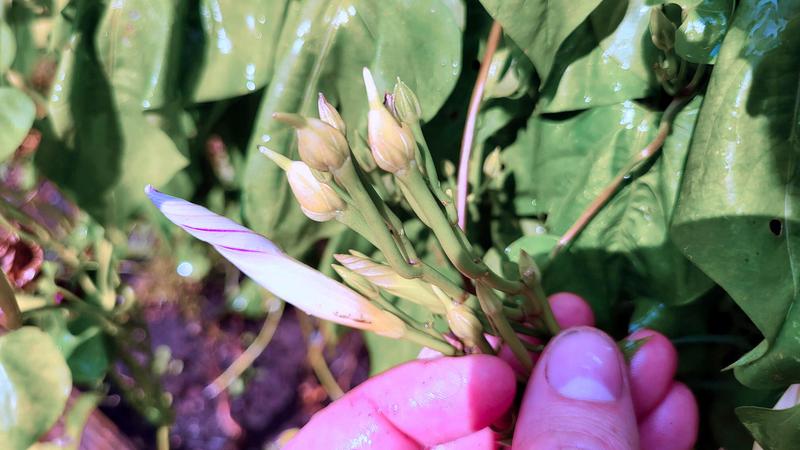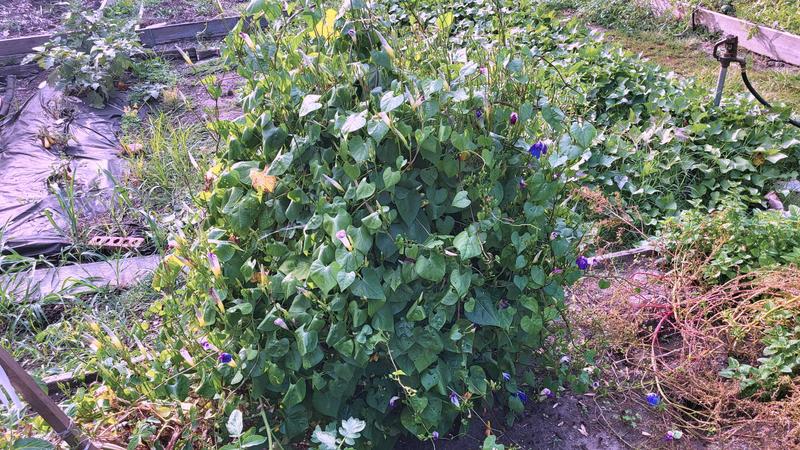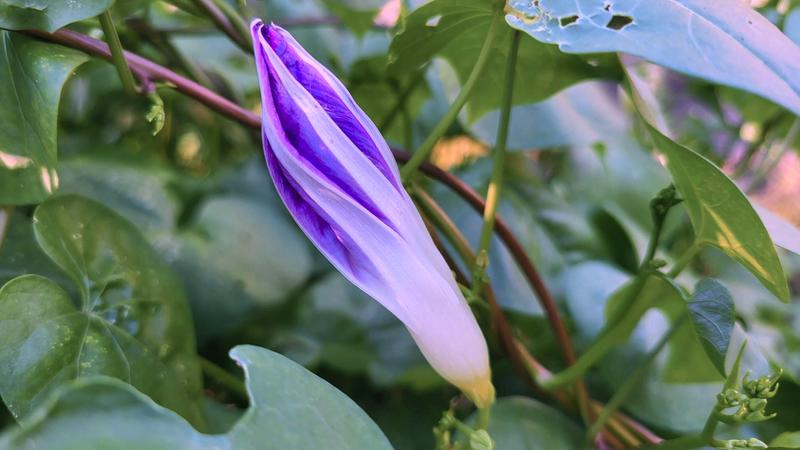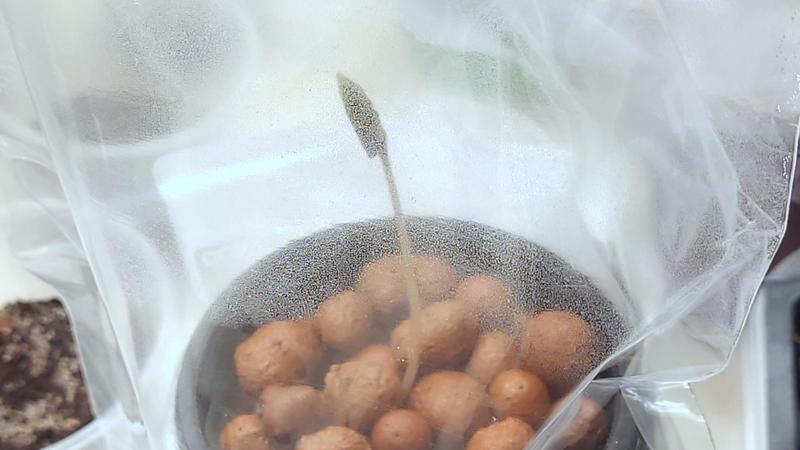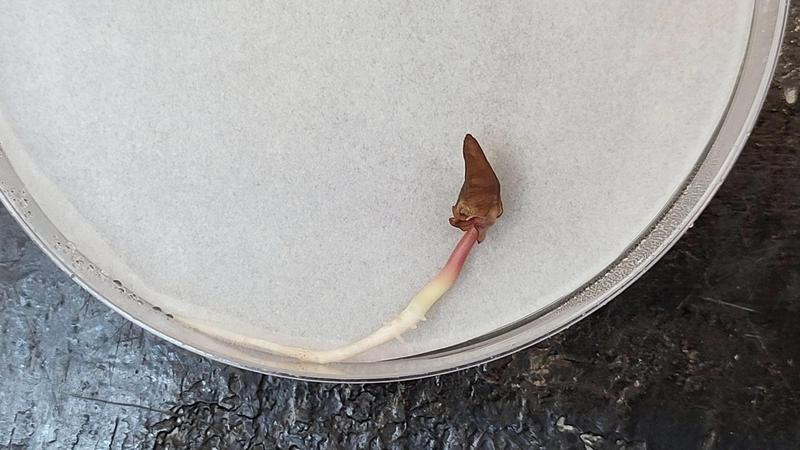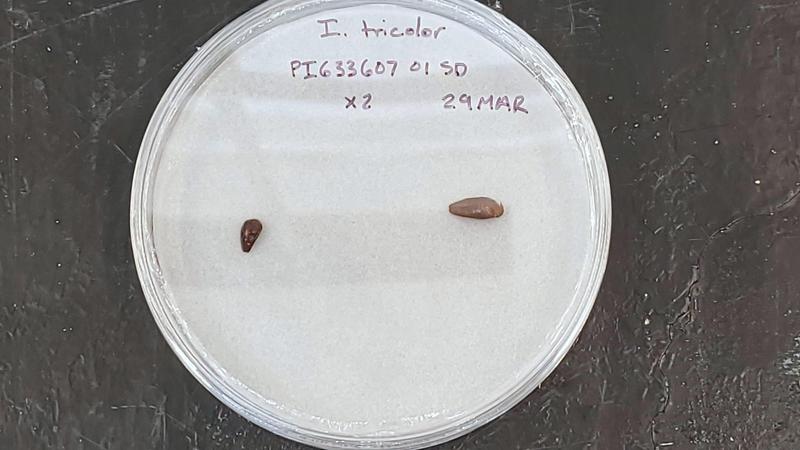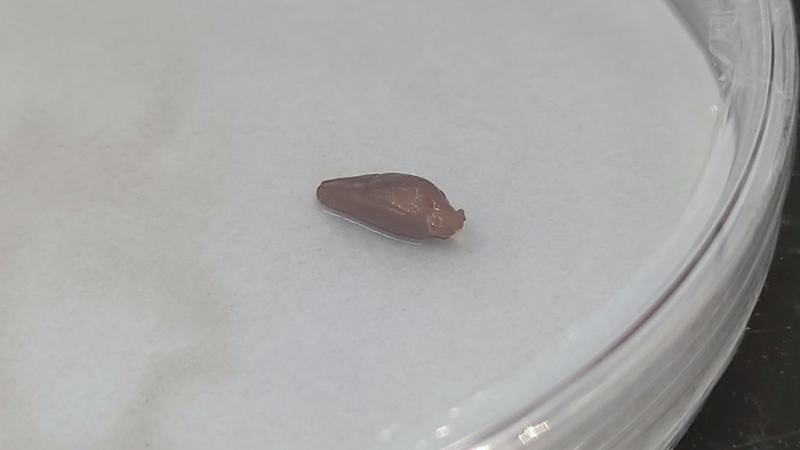Ipomoea tricolor
Propagation
Germination
| media | germination | temperature °C | note | reference |
|---|---|---|---|---|
Vegetative
In-Vitro
| basal media | supplements | source | target | note | reference |
|---|---|---|---|---|---|
Cultivation
| Planting density (m-2) | inter-row space (cm) | intra-row space (cm) | note | reference |
|---|---|---|---|---|
Harvest
Yield
| product | source | yield per season (kg/ha) | note | reference |
|---|---|---|---|---|
| product | source | yield per plant | note | reference |
|---|---|---|---|---|
Soilless
Tricolor can be grown in deep water culture hydroponics or sand-filled pots irrigated with the same hydroponic solution.[1]
Soil
| soil type | pH | C-content % | precipitation | temperature (°C) | altitude (m) | note | reference |
|---|---|---|---|---|---|---|---|
Fertilization
| type | rate | time | note | reference |
|---|---|---|---|---|
Pests
Ecology
Ergoline alkaloids are eliminated upon treatment of tricolor with fungicides.[2][3]
Fruit survival is 50% higher for endosymbiotic-positive females and two times higher for male parents. Endosymbiotic negative maternal and paternal donors had a seven times lower compared to both positive.[3]
Seeds from endosymbiotic-positive plants also have a higher germination rate and germinate faster.[3]
Morphology
| character | measurement | unit | notes | reference |
|---|---|---|---|---|
Roots
Stem
Leaves
Inflorescence
Tricolor flowers open in the morning and permanently close in the afternoon of the same day. This movement is largely in response to endogenous ethylene.[4][5][6]
Seeds
Phytochemistry
| compound | source | concentration (mg/g dry weight) | note | reference |
|---|---|---|---|---|
Ergoline alkaloids are derived from epibiotic clavicipitaceous fungi.[7][2][3]
Infraspecific Variation
Biosynthesis
Distribution
Timecourse
Improvement
| trait | improvement status | reference |
|---|---|---|
Identification
| variety | description | reference |
|---|---|---|
Inheritance
Methods
| type | note | reference |
|---|---|---|
History & Society
Work Log
26 Sep 2022
Attempting to clone the garden tricolor. Took a 1-foot terminal shoot. Split it into 3 sections of about 3 nodes. Dipped in rooting powder. Placed in sterile potting soil in a humidity dome.
17 Sep 2022
I haven’t been able to catch any of the flowers in their full glory. This one is already on its way out.
15 Sep 2022
One of the inflorescences shows buds and pollinated fruits.
I have completely neglected to take any pics of the plant developing.
31 Aug 2022
One of the flower buds.
07 Jun 2022
It’s a bit late in the season but I planted the seedling in the garden.
06 Apr 2022
The seedling was moved to LECA with 1/4 strength MB nutrients.
A plastic bag was put into place to increase humidity during the transition period.
The second seed has not germinated.
01 Apr 2022
First germination has lost its seed coat.
30 Mar 2022
Sowed two seeds. These are my last two from “PI633607 01 SD”.
The first germination occurred in less than 12 hours.
Bibliography
- K. Hikosaka, I. Terashima, and S. Katoh, “Effects of Leaf Age, Nitrogen Nutrition and Photon Flux Density on the Distribution of Nitrogen among Leaves of a Vine (Ipomoea Tricolor Cav.) Grown Horizontally to Avoid Mutual Shading of Leaves,” Oecologia, vol. 97, no. 4, pp. 451–457, May 1994.
doi: 10.1007/BF00325881.
Effects of leaf age, nitrogen nutrition and photon flux density (PFD) on the distribution of nitrogen among leaves were investigated in a vine, Ipomoea tricolor Cav., which had been grown horizontally so as to avoid mutual shading of leaves. The nitrogen content was highest in newly developed young leaves and decreased with age of leaves in plants grown at low nitrate concentrations and with all leaves exposed to full sunlight. Thus, a distinct gradient of leaf nitrogen content was formed along the gradient of leaf age. However, no gradient of leaf nitrogen content was formed in plants grown at a high nitrate concentration. Effects of PFD on the distribution of nitrogen were examined by shading leaves in a manner that simulated changes in the light gradient of an erect herbaceous canopy (i.e., where old leaves were placed under increasingly darker conditions with growth of the canopy). This canopy-type shading steepened the gradient of leaf nitrogen content in plants grown at a low nitrogen supply, and created a gradient in plants grown at high concentrations of nitrate. The steeper the gradient of PFD, the larger the gradient of leaf nitrogen that was formed. When the gradient of shading was inverted, that is, younger leaves were subjected to increasingly heavier shade, while keeping the oldest leaves exposed to full sunlight, an inverted gradient of leaf nitrogen content was formed at high nitrate concentrations. The gradient of leaf nitrogen content generated either by advance of leaf age at low nitrogen availability, or by canopy-type shading, was comparable to those reported for the canopies of erect herbaceous plants. It is concluded that both leaf age and PFD have potential to cause the non-uniform distribution of leaf nitrogen. It is also shown that the contribution of leaf age increases with the decrease in nitrogen nutrition level.
- S. Kucht et al., “Elimination of Ergoline Alkaloids Following Treatment of Ipomoea Asarifolia (Convolvulaceae) with Fungicides,” Planta, vol. 219, no. 4, pp. 619–625, Aug. 2004.
doi: 10.1007/s00425-004-1261-2.
Ergoline alkaloids are constituents of Clavicipitaceous fungi living on Poaceae plants. Ergoline alkaloids as well as volatile oil are also present in Ipomoea asarifolia Roem. & Schult (Convolvulaceae). Treatment of this plant with two fungicides (Folicur, Pronto Plus) eliminates the ergoline alkaloids but not the volatile oil. Elimination of ergoline alkaloids occurs concomitantly with loss of fungal hyphae associated with secretory glands on the upper leaf surface of the Ipomoea plant. Our observations suggest that accumulation of ergoline alkaloids in the Convolvulaceae may depend on the presence of a plant-associated fungus.
- L. A. Durden, “What’s the Story Morning Glory? Investigating the Ecological and Evolutionary Effects of the Hereditary Fungal Endosymbiont of Ipomoea Tricolor (Convolvulaceae),” PhD thesis, Indiana Universtiy, 2021. https://www.proquest.com/openview/ca131a915a62f0a075a7938c29847e02/1?pq-origsite=gscholar&cbl=18750&diss=y.
- H. L. Phillips and H. Kende, “Structural Changes in Flowers of Ipomoea Tricolor during Flower Opening and Closing,” Protoplasma, vol. 102, no. 3, pp. 199–215, Sep. 1980.
doi: 10.1007/BF01279588.
Examination of rib tissue of developing flower buds and flowers ofIpomoea tricolor utilizing the light and electron microscopes resulted in the identification of a group of inner epidermal cells which undergo dynamic structural changes during the two days prior to flowering, during flowering and during flower fading. Over a three-day period these cells undergo enlargement, modification of shape, reduction in wall thickness, extensive vacuolation and autophagic activity, transition from a ribosome-rich cytoplasm with stacked RER and dictyosome complexes to one with only a few isolated organelles and a limited number of ribosomes, and modification of the tonoplast membrane. In contrast, other cells of the rib vacuolate prior to flowering and exhibit no further changes. The structural changes in the inner epidermal cells suggest that they affect the turgor status of the cells and initiate the opening and eventual closing of the flower.
- J. Hurter, B. Blattmann, and M. Manser, “Flowers of Ipomoea Tricolor as Indicators of Ethylene Inducing Compounds,” Biochemie und Physiologie der Pflanzen, vol. 175, no. 4, pp. 307–313, Jan. 1980.
doi: 10.1016/S0015-3796(80)80071-0.
Ephemeral flowers of Ipomoea tricolor were tested with regard to their suitability for the rapid screening of senescence inducing chemical compounds. The system was standardized by the ethylene releasers 2-CEPA, CGA 17856 and CGA 15281 which accellerate the fading process, manifested by rolling up of the corolla, considerably. ACC, a precursor of ethylene biosynthesis in apple tissue, had an even more pronounced effect on the corolla. IAA, a known ethylene inducer when applied in supraoptimal doses, hastened the fading process noticably. Its conjugates with methionine and aspartic acid did not exceed the effect of IAA. IAA-Nε-lys was almost as active as IAA itself, whereas IAA-Nα-lys was of no importance in senescence. Rolling up of the corolla is inhibited by cycloheximide. However, AVG (ethyl analog of rhizobitoxin) an inhibitor of ethylene biosynthesis does not have the capability of cancelling the biological action of ACC. The various compounds that cause premature curling reactions in flowers evoke the production of ethylene in flower buds approaching maturity.
- H. Kende and B. Baumgartner, “Regulation of Aging in Flowers of Ipomoea Tricolor by Ethylene,” Planta, vol. 116, no. 4, pp. 279–289, Dec. 1974.
doi: 10.1007/BF00390853.
Flowers of Ipomoea tricolor Cav. open early in the morning and fade in the afternoon of the same day. Senescence, as manifested by curling-up of the corolla and by increase in RNase activity, can be induced prematurely by treatment with ethylene (C2H4). Conversely, aging of the flower can be delayed by treatment with CO2 or by absorption of endogenously produced C2H4 with mercuric perchlorate. C2H4 given for 20 or 40 min and removed before any signs of senescence can be observed also advances the onset of aging. In untreated flowers, fading of the corolla coincides with a sharp increase in the rate of endogenous C2H4 production. A 60-min treatment with C2H4 induces an immediate increase in the rate of endogenous C2H4 formation. A model is proposed to explain the mechanism by which C2H4 may induce C2H4 synthesis.
- U. Steiner and E. Leistner, “Ergoline Alkaloids in Convolvulaceous Host Plants Originate from Epibiotic Clavicipitaceous Fungi of the Genus Periglandula,” Fungal Ecology, vol. 5, no. 3, pp. 316–321, Jun. 2012.
doi: 10.1016/j.funeco.2011.04.004.
Ergoline (i.e., ergot) alkaloids are a group of physiologically active natural products occurring in the taxonomically unrelated fungal and plant taxa, Clavicipitaceae and Convolvulaceae, respectively. The disjointed occurrence of ergoline alkaloids seems to contradict the frequent observation that identical or at least structurally related natural products occur in organisms with a common evolutionary history. This problem has now been solved by the finding that not only graminaceous but also some dicotyledonous plants belonging to the family Convolvulaceae, such as Ipomoea asarifolia and Turbina corymbosa, form close associations with ergoline alkaloid producing fungi, Periglandula ipomoeae and Periglandula turbinae. These species belong to the newly established genus Periglandula within the Clavicipitaceae. The fungus–plant associations are likely to be mutualistic symbioses.

